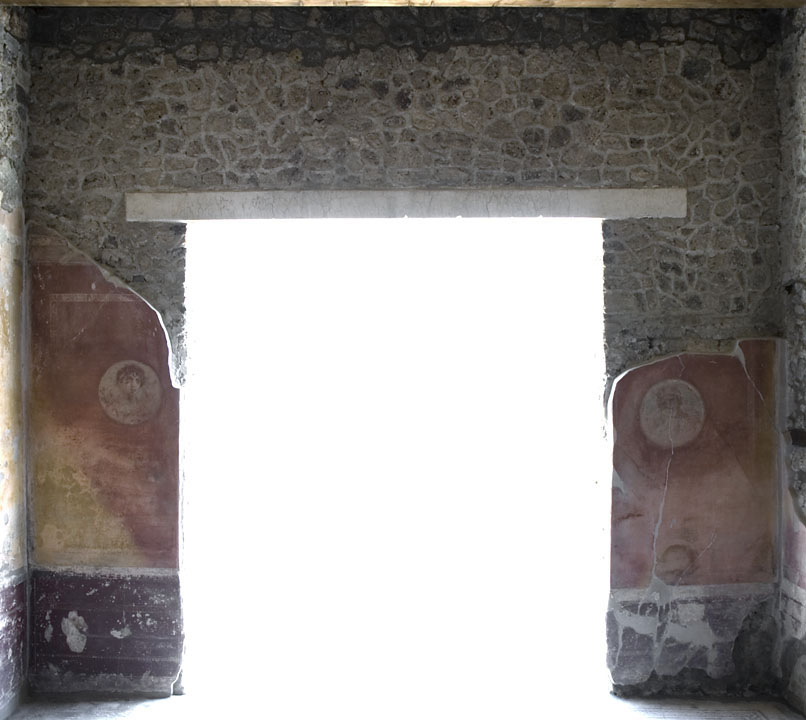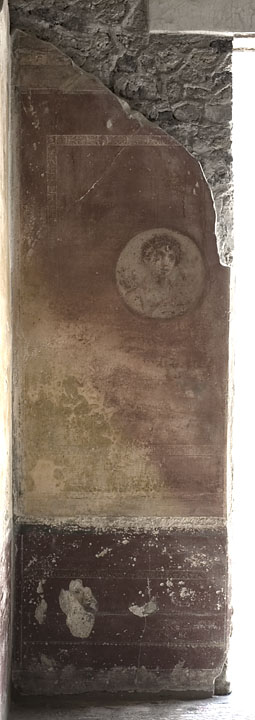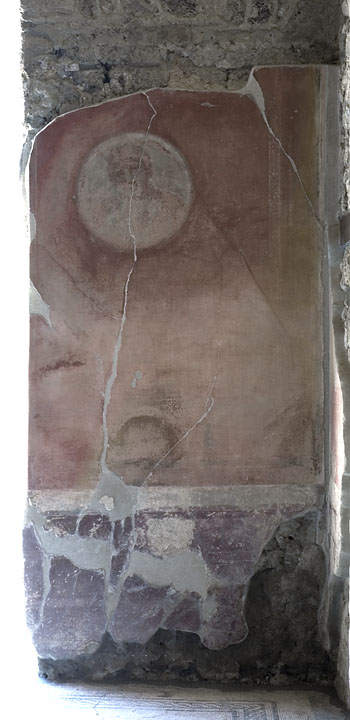South Wall
Description
A. Karivieri & R. Forsell
DESCRIPTION E PART
The wall is located between 26o and N portico.
The wall is built in opus incertum. The original wall was covered by wall plaster, which is preserved up to the upper zone in the SE corner.
Wall-plaster
The main zone preserves yellow colour in the lower edge but it turns reddish up and towards the entrance. The main zone has a central tondo showing a female portrait, the head turned slightly towards the entrance, this tondo has a circular framing band with small leaves. The main panel is framed by two bands, an inner white decorative band and an outer dark with white design above; there is also a narrow vertical band, in the E corner. The dado is dark red and has similar design as the W part of the S wall and the NE and NW corners of the N wall, with a white line at the lower edge, then a band with heart pendants, above it a band with green leaves in herringbone pattern, and above it, a yellow decorative band. The upper edge is decorated with a broad bluegreen band.
State of preservation
The visible part of wall structure is modern reconstruction.
The wall plaster is preserved up to the upper zone in the SE corner of the wall.
DESCRIPTION W PART
The wall is located between 26o and N portico.
The wall is built in opus incertum. The original wall is covered by the wall plaster, and a small piece of original wall is visible between the preserved edge of plaster and the reconstructed upper part of the wall. It seems that the wall-plaster has been lifted and reattached to its place since it is at a lower level than the eastern wall-plaster, and the plaster has been attached with a thick layer of modern mortar. The wall plaster has been attached from the height of 2.82 m and the lower edge is above the original floor level. The dado has been reattached to the wall in several pieces so that there is discrepancy between the decorative bands of the same design.
Wall-plaster
The main zone seems to be red, but in places the yellow colour indicates that it may have originally been yellow, as in the N wall. The design is similar to the outermost yellow panels in N wall, with a round tondo framed by two bands, the inner one with white decorative pattern, and the outer one, a dark coloured band with white painted pattern above it.
And in the innermost corner, there is a narrow vertical band. The tondo representing a female portrait, the head turned slightly towards the entrance, is placed off-centre, nearer to the entrance. The bust in the tondo is in bad condition.
The dark red dado has three horizontal bands. The lowermost yellow band with hanging heart pendants, the central band with green leaves in herringbone design, and the uppermost band has yellow pattern. The upper edge of dado consists of a broad horizontal bluegreen band.
State of preservation
The dado and the W corner are badly preserved.
Doorway between room o and N portico of peristyle.
The threshold consists of few pieces of Apennine limestone of various sizes and shapes (see separate sketch). By the door post there are slabs with square holes for door settings. The eastern has remains of a metal shoe (copper?). Between these slabs is a black mosaic with a black&white geometric decoration, 43 cm wide. The decoration consists of a frame of three white tesserae then inside of this frame, two rows of black tesserae. Against a white background there are 36 hatches in a row pointing towards the east.
The door posts probably had frames in a different material as the Apennine limestone slabs do not reach all the way out to the doorposts. One of the small slabs in the west may also be secondary.
State of preservation
Some pieces of limestone in the threshold may have been set there in modern times.
The mosaic is damaged in the eastern corner. Closest to the door post, in the east, there is no Apennine limestone slab. The slabs do not go under the walls.
MEASUREMENTS
The limestone slabs in the threshold are 4 cm high and 17, 5 cm wide in the centre.
The size of square pivot holes in the doorposts: the western 9 x 9 cm, the eastern 10 x 10 cm.
E Part:
The width of the wall:
The height of the dado is 103 cm. It has a white line at the lower edge, 17 cm above floor, a band with heart pendants 32 cm, above it a band with green leaves in herringbone pattern at the height of 49 cm, and above it, at the height 69-74 cm, yellow decorative border, and the upper edge of dado is decorated with broad bluegreen band, 10 cm high. There is a narrow vertical band, 3 cm wide, in the E corner.
The tondo is located at the height of 2.16 m above the floor, and its diameter is 52 cm. The lower dark band is at the heght of 1.13 m – 1.17 m and the second band is at the height of 1.39 – 1.44 m. The two bands in the corner are 5-7 cm wide together, and the inner decorative vertical white band is placed 20 cm from the E corner. The distance from the white band to the entrance where the wall-plaster is façetted is 1.00 m.
W Part:
The width of the plaster is 1.34 m and the E edge is façetted towards the door opening ca 4 cm wide edge.
The diameter of the tondo is 52 cm, and it is 1.95 m above the floor level.
The upper edge of the dado is at the level of 89 cm.The uppermost band in the dado has a yellow pattern: height 5.5 cm.



